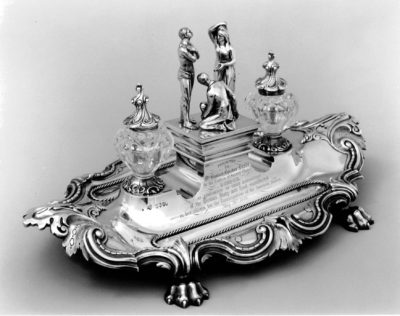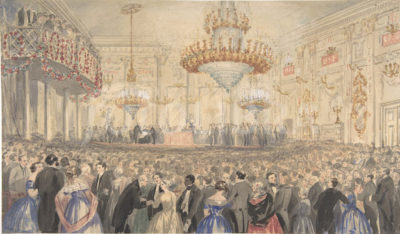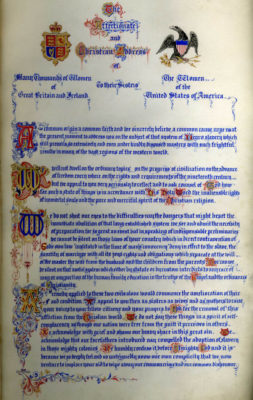Editor's Note
For previous entries in this series on cosmopolitan Christianity in early America, please see: The Christian and the Cosmos; The Puritan’s Grand Tour; The Preacher and the Pope.

The “Ladies of Surrey Chapel, London” presented this silver and crystal inkstand to Stowe on 26 May 1853 (Harriet Beecher Stowe Center)
Sailing into Liverpool in 1853, Harriet Beecher Stowe nearly overshadowed the Sabbath. Crowds poured out to meet the author of Uncle Tom’s Cabin
(1852). Laden with gifts, the local residents muffled the peal and chime of English church bells with loud cheers. “It looked like Love,” her brother Charles wrote, clearly in awe of the scene. At a seven-hour temperance meeting in Glasgow a few days later, Stowe’s fame again preceded her. Wild waves of applause greeted her turn to speak. “It seemed as though the next moment they would rise bodily and fly up,” Charles recalled. “And the best of it is—Hatty is worthy of it all, through the grace of that Savior who lives in her and in whom she lives.” In the eyes of the world, best-selling author Harriet Beecher Stowe embodied Christian celebrity. Part book tour, part activism: Stowe’s time in Britain also radically reset her faith.
Unlike Horace Bushnell, this Connecticut native made for a sensational visitor to Europe. Harriet Beecher Stowe’s cosmopolitan Christianity was largely the product of her literary rise. In April 1853, she was still grappling with the duties that accompanied it, and the nuances of promoting her antislavery politics. “The literary success of Uncle Tom’s Cabin made Harriet Beecher Stowe’s the single most powerful voice on behalf of the slave,” biographer Joan D. Hedrick wrote of Stowe’s activism, which included attending antislavery meetings back in Andover. Now Stowe readied to serve as a global advocate of abolition. But, as Hedrick observed: “Her preparation for this political role had been virtually nil.” Europe was a wholly new and complex field to explore. Like Bushnell, Stowe had traveled widely at home but never gone abroad. This venture marked the first of three trips to Europe over the next six years. Stowe battled exhaustion and illness during excursions to fulfill speaking engagements, visit schoolchildren, and pressure the British aristocracy to join Americans in the universal, Christian cause of antislavery.

William Henry Fisk, “Abolition Meeting Held at Willis’s Rooms in Honor of Harriet Beecher Stowe, 1853”
Stowe’s dealings with Old World faith stirred some of the same “soul-sickness” that Bushnell had evinced. But, significantly, Stowe came to believe that religion required cosmopolitanism in order to effect meaningful social reform of any kind. She enjoyed rooting out all of the “Americanisms” and “Anglicisms” of religion that travel forced her to confront and reinterpret. Her observations on foreign preaching styles and worship habits punctuated the glossy travel guide/antislavery tract that she wrote in 1854, Sunny Memories of Foreign Lands. Written with folksy charm, it was Stowe’s way of preaching abolitionism, always trusting that the world was Christian enough to support her views. “It is cheering to feel that an ocean does not divide our hearts,” she wrote in an early letter home, “and that the Christians of America and England are one.” Feeling encouraged in her cause, Stowe moved on.

More than 562,000 British and Irish women signed this “Affectionate and Christian Address…to their Sisters, the Women of the United States of America,” acknowledging Stowe’s antislavery crusade (Harriet Beecher Stowe Center)
Along the way, Stowe recorded glimpses of what she called “New England-like” religion. She pried apart strands of faith, trying to figure out which bits derived from English heritage or American innovation. Letters home to her father, Lyman Beecher, formed the centerpiece of Sunny Memories. Harriet assured readers that the state of English religion was “very encouraging…humble, active, and practical,” and that the “one Christianity” appeared to be in the first stages of “regenerating” there. From Stoke Newington in mid-May, Stowe reported an impressive session of the Congregational Union. The assembly’s “earnest, thoughtful, intelligent-looking men seemed to transport me back to my own country,” she wrote. New England religion remained Stowe’s gold standard for faith, yet she was not always a fluent expert when it came to explaining newer trends at home. She recalled, for example, her awkwardness when asked about “spirit-rappings” and séances.
As Stowe traveled, Biblical language comforted her and supplied the best vocabulary for her experiences. She especially liked the conversational preaching style of the English Congregationalist Thomas Binney, a fervent supporter of nonconformists and antislavery groups, who frequently made headlines. In all the months of town halls, church services, and private hymn circles, it was a homily of Binney’s that Stowe prized as her favorite lesson: Is It Possible to Make the Best of Both Worlds? Well-honed by a family of preachers, Stowe’s instinct for pulpit talent was right on target. Thomas Binney’s top sermon sold 31,000 copies in 1853, and when Stowe returned to Europe in 1856, it had just entered a tenth edition. In his address to members of London’s newly created Young Men’s Christian Association, Binney advised the steady inculcation of heroic Christian virtue in order to reconcile “the facts of the present world” with “the belief of another.”

George Richardson, “Harriet Beecher Stowe,” 1853, with her signature
Stowe found Binney to be a clear and logical teacher of Christian thought. Here, she thought, was a preacher who really understood his people. Binney used their life stories to engage in a higher dialogue about Scripture, stretching minds and hearts alike. Stowe was not so generous in her reviews of other clergy. She traded sharper critiques on British and American preaching with the London Anglican John Hampden Gurney. English clergymen stifled native spirituality with orthodoxy, Stowe argued. Further, they did not appreciate the Christian growth that came from practicing doubt. “In American sermons,” Stowe observed, “there is always more or less time employed in explaining, proving, and answering objections to, the truths enforced.” Here is a big cue to Stowe’s cosmopolitan Christianity, an emergent force that would rematerialize with mixed results in works like Oldtown Folks (1869). To her mind, in matters of religion, the English inherited and the Americans invented. Her first sight of Europe led the novelist to a new kind of religious truth, altering how she approached faith in her fiction. In order to save God’s creation, Stowe reckoned, she needed to see and test as many Christian worlds as she could.
NEXT: From Sunny Memories to Oldtown Folks

0